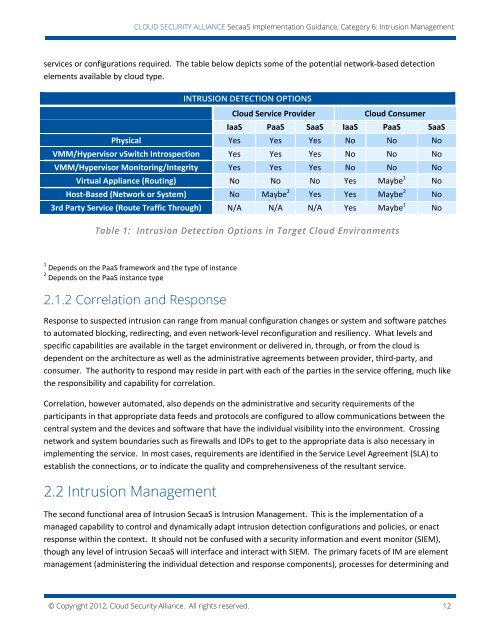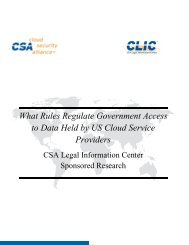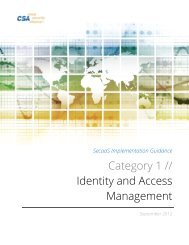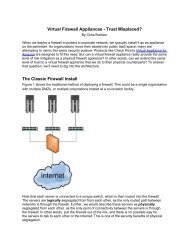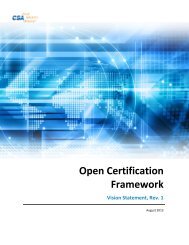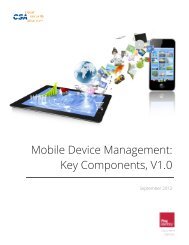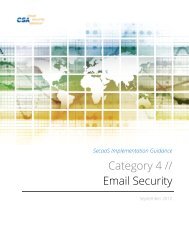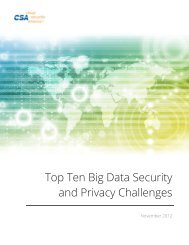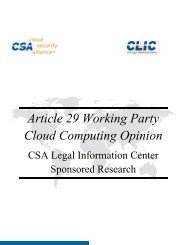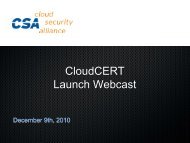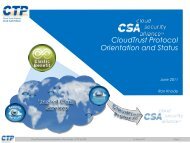Download - Cloud Security Alliance
Download - Cloud Security Alliance
Download - Cloud Security Alliance
- No tags were found...
You also want an ePaper? Increase the reach of your titles
YUMPU automatically turns print PDFs into web optimized ePapers that Google loves.
CLOUD SECURITY ALLIANCE SecaaS Implementation Guidance, Category 6: Intrusion Managementservices or configurations required. The table below depicts some of the potential network-based detectionelements available by cloud type.INTRUSION DETECTION OPTIONS<strong>Cloud</strong> Service Provider<strong>Cloud</strong> ConsumerIaaS PaaS SaaS IaaS PaaS SaaSPhysical Yes Yes Yes No No NoVMM/Hypervisor vSwitch Introspection Yes Yes Yes No No NoVMM/Hypervisor Monitoring/Integrity Yes Yes Yes No No NoVirtual Appliance (Routing) No No No Yes Maybe 1 NoHost-Based (Network or System) No Maybe 2 Yes Yes Maybe 2 No3rd Party Service (Route Traffic Through) N/A N/A N/A Yes Maybe 1 NoTable 1: Intrusion Detection Options in Target <strong>Cloud</strong> Environments1 Depends on the PaaS framework and the type of instance2 Depends on the PaaS instance type2.1.2 Correlation and ResponseResponse to suspected intrusion can range from manual configuration changes or system and software patchesto automated blocking, redirecting, and even network-level reconfiguration and resiliency. What levels andspecific capabilities are available in the target environment or delivered in, through, or from the cloud isdependent on the architecture as well as the administrative agreements between provider, third-party, andconsumer. The authority to respond may reside in part with each of the parties in the service offering, much likethe responsibility and capability for correlation.Correlation, however automated, also depends on the administrative and security requirements of theparticipants in that appropriate data feeds and protocols are configured to allow communications between thecentral system and the devices and software that have the individual visibility into the environment. Crossingnetwork and system boundaries such as firewalls and IDPs to get to the appropriate data is also necessary inimplementing the service. In most cases, requirements are identified in the Service Level Agreement (SLA) toestablish the connections, or to indicate the quality and comprehensiveness of the resultant service.2.2 Intrusion ManagementThe second functional area of Intrusion SecaaS is Intrusion Management. This is the implementation of amanaged capability to control and dynamically adapt intrusion detection configurations and policies, or enactresponse within the context. It should not be confused with a security information and event monitor (SIEM),though any level of intrusion SecaaS will interface and interact with SIEM. The primary facets of IM are elementmanagement (administering the individual detection and response components), processes for determining and© Copyright 2012, <strong>Cloud</strong> <strong>Security</strong> <strong>Alliance</strong>. All rights reserved. 12


